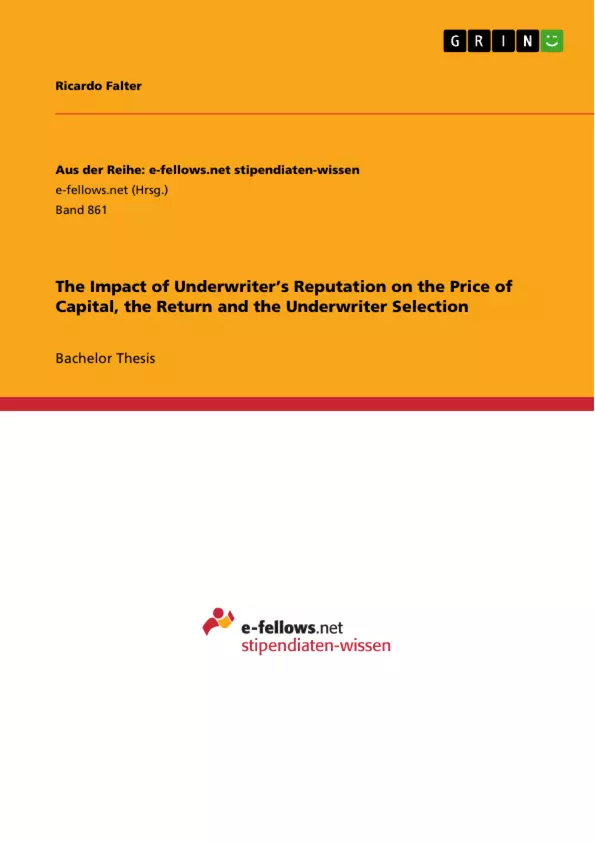This paper will try to elaborate on the different and sometimes mixed empirical results, testing the relationship between underwriter’s reputation and the price of the capital issue. Firstly, the two most cited and used ways of measuring reputation will be explained. Secondly, the relationship between reputation and issue pricing will be analysed from different perspectives. Thirdly, the existence of a relationship between reputation and fees as well as between reputation and proceeds will be proven. After that commercial and investment banks as underwriters will be compared and it will be shown that there are reasons to choose a commercial bank as an underwriter. Finally, the mechanics of how underwriters are being chosen and the reasons for switching underwriters will be analysed, before ending this study with a conclusion.
Inhaltsverzeichnis (Table of Contents)
- Introduction
- How Reputation is Measured
- Tombstone Announcement Measure
- Market Share Measure
- The Relationship between Underwriter Reputation and Issue Pricing
- Overpricing, Underpricing and Asymmetric Information
- The Underpricing Equilibrium
- Price Support
- Fees and Proceeds
- Fees
- Proceeds
- Commercial vs. Investment Banks
- How Are Underwriters Being Chosen and Why Do Companies Switch Underwriters?
- Conclusion
Zielsetzung und Themenschwerpunkte (Objectives and Key Themes)
This paper aims to explore the impact of underwriter reputation on the pricing of capital issues, return, and underwriter selection. The study examines the relationship between underwriter reputation and the pricing of capital issues, considering factors such as asymmetric information and the "certification effect." The paper also delves into the role of reputation in determining fees and proceeds, and analyzes the differences between commercial and investment banks as underwriters. Finally, it investigates the selection process for underwriters and the reasons behind companies switching underwriters.
- The relationship between underwriter reputation and issue pricing
- The impact of asymmetric information and the "certification effect" on issue pricing
- The role of reputation in determining fees and proceeds
- The differences between commercial and investment banks as underwriters
- The selection process for underwriters and the reasons behind company switching
Zusammenfassung der Kapitel (Chapter Summaries)
The introduction provides an overview of the context and importance of underwriters in capital issuance. It highlights the advantages of utilizing underwriters, including their established networks, expertise, and economies of scale.
The second chapter defines and explains the two most commonly used methods of measuring underwriter reputation: the Tombstone Announcement Measure and the Market Share Measure. The Tombstone Announcement Measure, also known as the Carter-Manaster Measure, utilizes the order in which underwriters are listed in tombstone announcements to derive a ranking of their reputation. The Market Share Measure, on the other hand, relies on the underwriter's market share in a specific market to assess their reputation.
The third chapter delves into the relationship between underwriter reputation and issue pricing. The study examines the role of reputation in supporting or determining the "certification effect" and considers the impact of asymmetric information on investor behavior. The chapter also discusses the concepts of overpricing, underpricing, and the underpricing equilibrium.
The fourth chapter explores the relationship between reputation, fees, and proceeds. The paper examines how underwriter reputation influences the fees they charge and the proceeds they generate from capital issues.
The fifth chapter compares commercial and investment banks as underwriters, highlighting the potential benefits of selecting a commercial bank in specific circumstances.
Schlüsselwörter (Keywords)
The paper focuses on the key concepts of underwriter reputation, capital issue pricing, asymmetric information, "certification effect," fees, proceeds, commercial banks, investment banks, and underwriter selection. The study examines empirical results and explores the relationship between these concepts, providing valuable insights into the role of underwriter reputation in the capital market.
- Citar trabajo
- Ricardo Falter (Autor), 2013, The Impact of Underwriter’s Reputation on the Price of Capital, the Return and the Underwriter Selection, Múnich, GRIN Verlag, https://www.grin.com/document/266032



